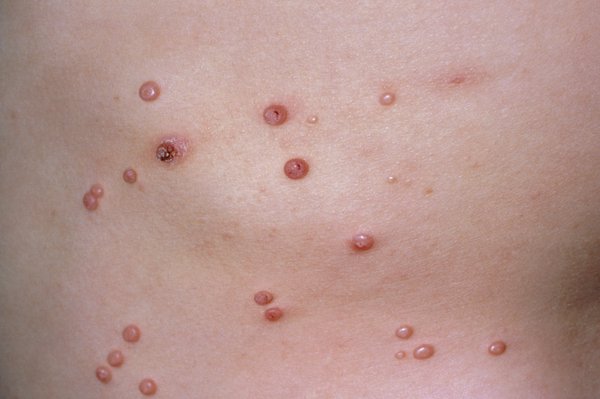
Introduction to Molluscum Contagiosum
Molluscum contagiosum is a common skin condition caused by a virus. It is characterized by small, raised bumps that can appear anywhere on the body. These bumps are usually painless and can range in size from 1 millimeter to 5 millimeters. They may be either round or oval-shaped, with a dimple in the center. Molluscum contagiosum is contagious and is spread through skin-to-skin contact or through contact with contaminated objects such as towels or clothing.
It is most commonly seen in children but can also affect adults and people with weakened immune systems. The good news is that molluscum contagiosum can be effectively treated in most cases. Treatment options vary depending on the severity of the condition, but typically involve physical removal of the bumps using methods such as cryotherapy (freezing), laser therapy, or topical ointments.
In some cases, medications may be prescribed to help reduce symptoms and speed up healing time. Additionally, it’s important to practice good hygiene habits to prevent the spread of molluscum contagiosum and other infections.
Overview of Symptoms of Molluscum Contagiosum
Molluscum contagiosum is a skin infection caused by a virus, and it is highly contagious. It can affect people of all ages, but is most commonly seen in children. The most common symptom of molluscum contagiosum is the appearance of small, flesh-colored or pinkish bumps on the skin. These bumps can range in size from as small as a pinhead to as large as a pencil eraser.
They may be itchy or sore, and may have a dimple in the center. In some cases, the bumps may contain pus or fluid. Other symptoms include thickening slopes unblocked of the skin around the bumps and redness or discoloration of the skin near the bumps.
Treatment Options for Molluscum Contagiosum
Molluscum contagiosum is a common skin condition that is caused by a virus. It can result in red or pink bumps on the skin, usually on the face, neck, armpits, hands and feet. While it is not dangerous, it can be quite irritating and uncomfortable. Fortunately, there are several different treatment options available to help treat molluscum contagiosum. One of the most common treatments for molluscum contagiosum is cryotherapy.
This involves freezing the bumps with liquid nitrogen or carbon dioxide to remove them from the skin. Cryotherapy is generally safe and effective but may cause some pain or discomfort during treatment. Another option for treating molluscum contagiosum is topical creams or ointments that contain antiviral medications like podophyllotoxin or imiquimod. These medications work by attacking the virus that causes molluscum contagiosum and helping to reduce its symptoms.
They can be applied directly to the affected areas of skin and should be used as directed by your doctor. In some cases, laser therapy may also be used to treat molluscum contagiosum. Laser therapy works by using high-energy light beams to destroy the virus cells that cause molluscum contagiosum. This treatment can be painful and may require multiple sessions in order to achieve full results. Finally, surgical removal of molluscum lesions may also be an option if other treatments have not been successful.
This procedure involves cutting away the lesions with a scalpel and cauterizing them with an electric current in order to prevent any further infection or spread of the virus. Surgery is generally considered a last resort option as it can leave scars if done improperly. It’s important to talk to your doctor about your individual case before deciding which treatment option is best for you. Treatments vary depending on factors such as age, severity of infection and underlying medical conditions so it’s important to discuss all of these with your doctor before beginning any form of treatment for molluscum contagiosum.
Home Remedies for Molluscum Contagiosum
Molluscum contagiosum is a skin infection caused by a virus. It typically appears as small, raised bumps on the skin that are usually painless. While it can affect people of any age, it is more common in children. Fortunately, there are several home remedies that can help treat molluscum contagiosum. The first home remedy for molluscum contagiosum is to apply a warm compress to the affected area several times a day.
This helps to soften the bumps and reduce inflammation. It is also important to avoid scratching or picking at the bumps as this can spread the infection and cause scarring. Another home remedy for molluscum contagiosum is to use tea tree oil. Tea tree oil has antiseptic and anti-inflammatory properties which can help reduce irritation and inflammation associated with the infection. To use tea tree oil, mix one part tea tree oil with nine parts water and apply it directly to the affected area twice daily.
Apple cider vinegar is another effective home remedy for molluscum contagiosum due to its acidic properties which help kill bacteria on the skin’s surface. To use apple cider vinegar, mix one part apple cider vinegar with nine parts water mlb66 ir and apply it directly to the affected area twice daily until the bumps have disappeared. Finally, garlic is an effective home remedy for molluscum contagiosum due to its antiviral properties which can help fight off viruses on the skin’s surface.
To use garlic, crush one clove of garlic into a paste and apply it directly to the affected area twice daily until the bumps have disappeared. While these home remedies may be effective in treating molluscum contagiosum, if symptoms persist or worsen it is important to contact your doctor as soon as possible for further medical advice and treatment options.
Conclusion
Molluscum contagiosum is a common skin condition that can be effectively treated with the right approach. If you think you have molluscum contagiosum, it’s important to visit your doctor for a proper diagnosis and treatment plan. Treatment options include topical creams, cryotherapy, laser treatments, and natural remedies. It’s important to follow your doctor’s recommendations for treatment and take steps to prevent the spread of molluscum contagiosum. With the right treatment plan, you can effectively treat molluscum contagiosum and reduce the risk of further infection.







